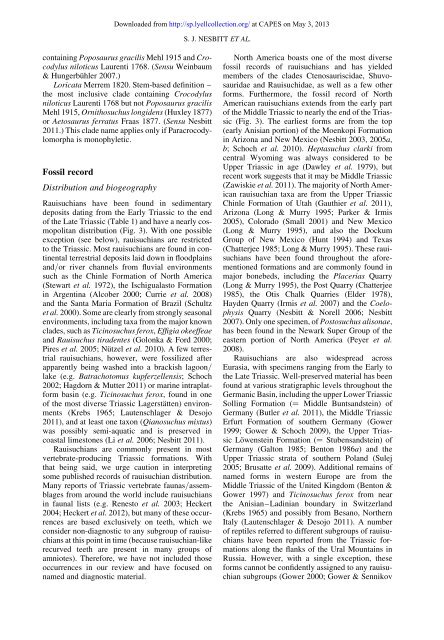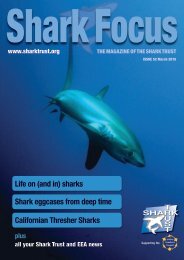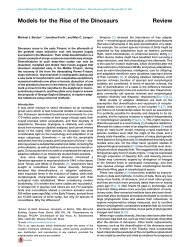(044) Nesbitt et al 2013
(044) Nesbitt et al 2013
(044) Nesbitt et al 2013
Create successful ePaper yourself
Turn your PDF publications into a flip-book with our unique Google optimized e-Paper software.
Downloaded from http://sp.lyellcollection.org/ at CAPES on May 3, <strong>2013</strong>S. J. NESBITT ET AL.containing Poposaurus gracilis Mehl 1915 and Crocodylusniloticus Laurenti 1768. (Sensu Weinbaum& Hungerbühler 2007.)Loricata Merrem 1820. Stem-based definition –the most inclusive clade containing Crocodylusniloticus Laurenti 1768 but not Poposaurus gracilisMehl 1915, Ornithosuchus longidens (Huxley 1877)or A<strong>et</strong>osaurus ferratus Fraas 1877. (Sensu <strong>Nesbitt</strong>2011.) This clade name applies only if Paracrocodylomorphais monophyl<strong>et</strong>ic.Fossil recordDistribution and biogeographyRauisuchians have been found in sedimentarydeposits dating from the Early Triassic to the endof the Late Triassic (Table 1) and have a nearly cosmopolitandistribution (Fig. 3). With one possibleexception (see below), rauisuchians are restrictedto the Triassic. Most rauisuchians are found in continent<strong>al</strong>terrestri<strong>al</strong> deposits laid down in floodplainsand/or river channels from fluvi<strong>al</strong> environmentssuch as the Chinle Formation of North America(Stewart <strong>et</strong> <strong>al</strong>. 1972), the Ischigu<strong>al</strong>asto Formationin Argentina (Alcober 2000; Currie <strong>et</strong> <strong>al</strong>. 2008)and the Santa Maria Formation of Brazil (Schultz<strong>et</strong> <strong>al</strong>. 2000). Some are clearly from strongly season<strong>al</strong>environments, including taxa from the major knownclades, such as Ticinosuchus ferox, Effigia okeeffeaeand Rauisuchus tiradentes (Golonka & Ford 2000;Pires <strong>et</strong> <strong>al</strong>. 2005; Nützel <strong>et</strong> <strong>al</strong>. 2010). A few terrestri<strong>al</strong>rauisuchians, however, were fossilized afterapparently being washed into a brackish lagoon/lake (e.g. Batrachotomus kupferzellensis; Schoch2002; Hagdorn & Mutter 2011) or marine intraplatformbasin (e.g. Ticinosuchus ferox, found in oneof the most diverse Triassic Lagerstätten) environments(Krebs 1965; Lautenschlager & Desojo2011), and at least one taxon (Qianosuchus mixtus)was possibly semi-aquatic and is preserved incoast<strong>al</strong> limestones (Li <strong>et</strong> <strong>al</strong>. 2006; <strong>Nesbitt</strong> 2011).Rauisuchians are commonly present in mostvertebrate-producing Triassic formations. Withthat being said, we urge caution in interpr<strong>et</strong>ingsome published records of rauisuchian distribution.Many reports of Triassic vertebrate faunas/assemblagesfrom around the world include rauisuchiansin faun<strong>al</strong> lists (e.g. Renesto <strong>et</strong> <strong>al</strong>. 2003; Heckert2004; Heckert <strong>et</strong> <strong>al</strong>. 2012), but many of these occurrencesare based exclusively on te<strong>et</strong>h, which weconsider non-diagnostic to any subgroup of rauisuchiansat this point in time (because rauisuchian-likerecurved te<strong>et</strong>h are present in many groups ofamniotes). Therefore, we have not included thoseoccurrences in our review and have focused onnamed and diagnostic materi<strong>al</strong>.North America boasts one of the most diversefossil records of rauisuchians and has yieldedmembers of the clades Ctenosauriscidae, Shuvosauridaeand Rauisuchidae, as well as a few otherforms. Furthermore, the fossil record of NorthAmerican rauisuchians extends from the early partof the Middle Triassic to nearly the end of the Triassic(Fig. 3). The earliest forms are from the top(early Anisian portion) of the Moenkopi Formationin Arizona and New Mexico (<strong>Nesbitt</strong> 2003, 2005a,b; Schoch <strong>et</strong> <strong>al</strong>. 2010). Heptasuchus clarki fromcentr<strong>al</strong> Wyoming was <strong>al</strong>ways considered to beUpper Triassic in age (Dawley <strong>et</strong> <strong>al</strong>. 1979), butrecent work suggests that it may be Middle Triassic(Zawiskie <strong>et</strong> <strong>al</strong>. 2011). The majority of North Americanrauisuchian taxa are from the Upper TriassicChinle Formation of Utah (Gauthier <strong>et</strong> <strong>al</strong>. 2011),Arizona (Long & Murry 1995; Parker & Irmis2005), Colorado (Sm<strong>al</strong>l 2001) and New Mexico(Long & Murry 1995), and <strong>al</strong>so the DockumGroup of New Mexico (Hunt 1994) and Texas(Chatterjee 1985; Long & Murry 1995). These rauisuchianshave been found throughout the aforementionedformations and are commonly found inmajor bonebeds, including the Placerias Quarry(Long & Murry 1995), the Post Quarry (Chatterjee1985), the Otis Ch<strong>al</strong>k Quarries (Elder 1978),Hayden Quarry (Irmis <strong>et</strong> <strong>al</strong>. 2007) and the CoelophysisQuarry (<strong>Nesbitt</strong> & Norell 2006; <strong>Nesbitt</strong>2007). Only one specimen, of Postosuchus <strong>al</strong>isonae,has been found in the Newark Super Group of theeastern portion of North America (Peyer <strong>et</strong> <strong>al</strong>.2008).Rauisuchians are <strong>al</strong>so widespread acrossEurasia, with specimens ranging from the Early tothe Late Triassic. Well-preserved materi<strong>al</strong> has beenfound at various stratigraphic levels throughout theGermanic Basin, including the upper Lower TriassicSolling Formation (¼ Middle Buntsandstein) ofGermany (Butler <strong>et</strong> <strong>al</strong>. 2011), the Middle TriassicErfurt Formation of southern Germany (Gower1999; Gower & Schoch 2009), the Upper TriassicLöwenstein Formation (¼ Stubensandstein) ofGermany (G<strong>al</strong>ton 1985; Benton 1986a) and theUpper Triassic strata of southern Poland (Sulej2005; Brusatte <strong>et</strong> <strong>al</strong>. 2009). Addition<strong>al</strong> remains ofnamed forms in western Europe are from theMiddle Triassic of the United Kingdom (Benton &Gower 1997) and Ticinosuchus ferox from nearthe Anisian–Ladinian boundary in Switzerland(Krebs 1965) and possibly from Besano, NorthernIt<strong>al</strong>y (Lautenschlager & Desojo 2011). A numberof reptiles referred to different subgroups of rauisuchianshave been reported from the Triassic formations<strong>al</strong>ong the flanks of the Ur<strong>al</strong> Mountains inRussia. However, with a single exception, theseforms cannot be confidently assigned to any rauisuchiansubgroups (Gower 2000; Gower & Sennikov




